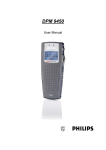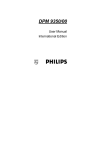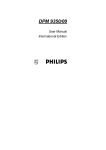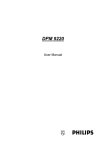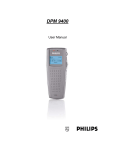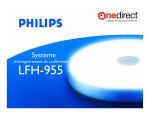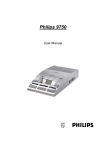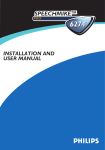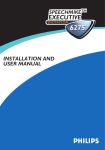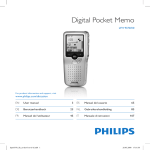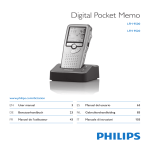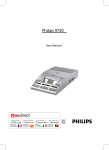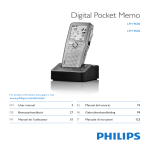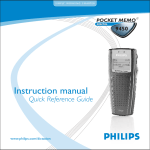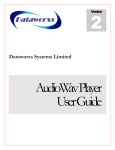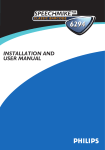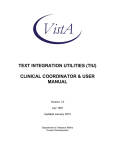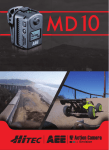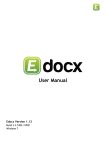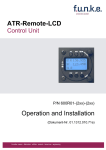Download + User Manual (PDF 341 KB)
Transcript
DPM 9360 User Manual DPM 9360 - User Manual VERSION DPM 9360 - 05/2005 (English) COPYRIGHT © 2003 - 2005 Philips Austria GmbH, PSP - Dictation Systems. All rights reserved. Reproduction in whole or in part is prohibited without the written consent of the copyright owner. Information in this manual is subject to change without notice. TRADEMARKS ® Pocket Memo is a registered trademark of Philips. Windows 2000 and Windows XP are registered trademarks of Microsoft Corporation. All other names are trademarks, registered trademarks or service marks of their respective owners. DISCLAIMER AND NOTICES Philips has carried out extensive testing with most popular configurations. However, since PC add-ons and device drivers change very rapidly, we are unable to guarantee conflict-free operation. The CE mark confirms that the device corresponds to the relevant guidelines of the European Union. The cardboard used for packaging can be recycled. This electronic facility contains recyclable material. Technical changes and errors excepted. Please note that not all accessories mentioned in this manual are necessarily part of the package contents. Descriptions of accessories, such as memory cards, additional microphones or the Foot Control, are for information only and do not require Philips to deliver any of these accessories with DPM 9360. Declaration of Conformity Tested to comply with FCC standards. For home or office use. Model number: DPM 9360 Trade name: Philips Digital Pocket Memo Responsible party: Philips Speech Processing - Dictation Systems Address: 64 Perimeter Center East, Fifth Floor, Atlanta, GA 30346, USA Telephone number: +1 770 821 2400 This device complies with Part 15 of the FCC Rules. Operation is subject to the following two conditions: 1. This device may not cause harmful interference. 2. This device must accept any interference received, including interference that may cause undesired operation. ii DPM 9360 - User Manual Table of Contents Chapter 1: Introduction......................................................................................................................... 1 DPM features ..................................................................................................................................................... 1 Package contents .............................................................................................................................................. 1 Chapter 2: Introducing the DPM .......................................................................................................... 2 DPM graphic ...................................................................................................................................................... 2 LCD display ....................................................................................................................................................... 3 Batteries............................................................................................................................................................. 4 Recharging the batteries .............................................................................................................................. 4 Chapter 3: Getting Started.................................................................................................................... 5 Activating the DPM ............................................................................................................................................ 5 Memory card ...................................................................................................................................................... 5 Formatting the memory card ........................................................................................................................ 5 Full memory card.......................................................................................................................................... 6 Start screen ....................................................................................................................................................... 6 Display appearance ........................................................................................................................................... 7 DPM menu ......................................................................................................................................................... 7 Accessing the DPM menu ............................................................................................................................ 7 User-defined labels ...................................................................................................................................... 8 Assigning Keywords ..................................................................................................................................... 8 Setting the date and time (DPM 9360/00) .................................................................................................... 8 Setting the date and time (DPM 9360/52) .................................................................................................... 9 Setting the recording format ....................................................................................................................... 10 DPM device beep ....................................................................................................................................... 10 Setting the microphone sensitivity .............................................................................................................. 10 Voice-activated recording........................................................................................................................... 10 Backlight on/off........................................................................................................................................... 11 Changing the contrast ................................................................................................................................ 11 Displaying the recording time ..................................................................................................................... 11 Reformatting the memory card ................................................................................................................... 11 Power Save mode............................................................................................................................................ 12 Chapter 4: Basic Operations .............................................................................................................. 13 Recording - DPM 9360/00 ............................................................................................................................... 13 Recording - DPM 9360/52 ............................................................................................................................... 14 Finishing a dictation (EOL)............................................................................................................................... 14 Recording mode (Insert/Overwrite) .................................................................................................................. 15 Playback .......................................................................................................................................................... 15 Adjusting the volume .................................................................................................................................. 15 Fast Forward and Fast Rewind ........................................................................................................................ 16 DPM 9360/00 ............................................................................................................................................. 16 DPM 9360/52 ............................................................................................................................................. 16 Deleting............................................................................................................................................................ 16 Deleting a section....................................................................................................................................... 16 Deleting a file ............................................................................................................................................. 17 Recording format (Standard Play/Long Play mobile) ....................................................................................... 17 Voice-activated recording ................................................................................................................................ 17 DPM 9360/00 ............................................................................................................................................. 17 DPM 9360/52 ............................................................................................................................................. 18 Skip Forward and Skip Back ............................................................................................................................ 18 Chapter 5: Advanced Operations ...................................................................................................... 19 Inserting index marks....................................................................................................................................... 19 Deleting index marks.................................................................................................................................. 19 Entering user-defined labels ............................................................................................................................ 19 Assigning Keywords......................................................................................................................................... 20 Example: Assigning Keywords ................................................................................................................... 21 Transferring data between DPM and PC ......................................................................................................... 21 Appendix: Troubleshooting the DPM ................................................................................................ 23 Index ..................................................................................................................................................... 25 iii DPM 9360 - User Manual iv DPM 9360 - User Manual Chapter 1: Introduction The DPM 9360 (Digital Pocket Memo) has been designed to offer optimum user convenience and greater efficiency for your daily work. This manual provides a comprehensive overview of all the device's features and detailed instructions on how to operate the device. DPM features • The DPM 9360 is a state-of-the-art digital voice recorder for the professional user. • Digital recording allows instant access to any point in the dictation and enables you to make precise deletions from sound files and to correctly place insertions. • The DPM 9360 provides workflow management capabilities for easy transfer of files to the PC. • 4-Position Switch for single-handed operation and ease-of-use. • User-defined information (Keywords and labels) can be stored with the sound file. • USB connection for simple data transfer between the device and the PC. • Ergonomic design. • High-resolution LCD display with backlight. Package contents • DPM 9360 - the digital voice recorder for the professional user. • Philips memory card of the type MMC. • Installation CD for SpeechExec Dictate for Windows 2000 and Windows XP. • A luxury pouch. • 2 Philips AAA batteries. • A USB cable. • Quick Reference for DPM 9360/00 or DPM 9360/52. Accessories available from your vendor • Power Supply LFH 9145 • DPM Docking Station 9110 • Rechargeable batteries LFH 9144 For more information on Philips and the available products, go to: www.philips.com www.philips.com/dictation 1 DPM 9360 - User Manual Chapter 2: Introducing the DPM This chapter introduces the DPM 9360. Below you find a graphic of the device which shows and explains the various parts. You also find a detailed description of the DPM display and useful information on how to operate the device with batteries. DPM graphic The following graphics show the device and the names of the various parts. 1 4 2 5 6 3 7 8 9 10 1: Record LED: Depending on the setting for the Recording mode, the LED can be either red or green. In Overwrite mode the LED is red; Overwrite is the default setting for the Recording mode. In Insert mode, the LED is green. 2: LCD display. 3: Built-in loudspeaker. 4: Built-in microphone. 5: Jog Dial ( ): Volume control, Skip Forward and Skip Back, access to the DPM menu and moving between menu entries, and confirmation of selections. 6: 4-Position Switch with Lock/Hold switch functionality. Depending on your DPM model, the positions on the 4-Position Switch are (from top to bottom): DPM 9360/00: Fast Forward ( ), Play ( ), Stop ( ) and Fast Rewind ( ). DPM 9360/52: Record (REC), Stop (STOP), Play (PLAY), Fast Rewind (FRWD). 7: INS/OVR: Button for switching between Insert (INS) and Overwrite (OVR) mode. 8: DEL: The Delete button. 9: USB socket. 10: Battery compartment. 2 DPM 9360 - User Manual 11 13 12 14 15 16 17 11: Memory card slot: Insert the memory card and push it down until you hear a click. To remove the memory card from the DPM, push it down again until you hear the click. 12: EOL: Press this button to evoke the End-of-Letter function which marks the dictation as finished. 13: MIC: The microphone socket. 14: EAR: The earphone socket. 15: The function of this button depends on your DPM model: DPM 9360/00: Record (REC). DPM 9360/52: Fast Forward (FFWD). 16: DL/INDEX: This is a multi-function button which supports the following operations: • When the DPM is connected to the PC, this button activates the download function. • When you press the button for about 0.3 seconds in Playback or Recording mode, an index mark is inserted into the sound file. 17: Power supply socket for Philips LFH 9145. LCD display The DPM 9360 has a high-quality graphical LCD display. You will see the following symbols: Standard Play Long Play mobile AM symbol (hours before noon) PM symbol (hours after noon) Fast Rewind Fast Forward Recording Playback Stop Voice-activated recording EOL (End-of-Letter) Write-protected SD card Insert mode Batteries: 100% Batteries: 80% Batteries: 60% Batteries: 40% Batteries: 20% Batteries: empty 3 DPM 9360 - User Manual Status indication bar The status indication bar may appear as follows (note that the following overview only lists the most common displays of the status indication bar): : A dictation is being recorded. : A sound file is being played back. : A section of the sound file is marked for deletion. : The whole sound file is marked for deletion. : The sound file has index marks. Batteries The DPM 9360 can be operated with the two standard AAA alkaline batteries delivered with the product. You can also use rechargable Philips NiMH batteries (LFH 9144). For recharging the batteries, only use the power supply LFH 9145; it can also be used for running the DPM from the mains power supply. The power indicator on the display may appear as follows: : The batteries are full (100%). : 4/5 of the battery power is available (80%). : 3/5 of the battery power available (60%). : 2/5 of the battery power available (40%). : 1/5 of the battery power available (20%). : The batteries are empty and should be replaced. If the batteries are dangerously low and should be replaced or recharged, this symbol is displayed: Note: If the power level in the batteries drops below 2.0 V, no recording or playback is possible. Recharging the batteries The DPM can be operated with the rechargable Philips NiMH batteries LFH 9144. For recharging these batteries, either use the DPM Docking Station 9110 or the Philips power supply LFH 9145. For more information on recharging the batteries with the DPM Docking Station 9110, refer to the documentation delivered with the product. To recharge the batteries (fast recharge) with the Philips power supply LFH 9145, do the following: 1. Connect the Philips power supply LFH 9145 to the mains power supply. 2. Deactivate the DPM via the Lock/Hold switch; this starts the recharging process. Important: The DPM can become quite warm during fast recharging. The recharging process is indicated on the DPM display with these alternating symbols: and When recharging is finished, only the symbol for full battery power is displayed: Note: When working with standard rechargable batteries, the DPM only displays the symbol for 80% battery power ( ) even if the batteries have been fully recharged. The symbol for 100% battery power ( ) is only displayed when completely new standard batteries (not rechargable) are inserted or when the DPM is run from the mains power supply. 4 DPM 9360 - User Manual Chapter 3: Getting Started This chapter provides an introduction to the basic functions of the DPM 9360: • Activating the DPM • Memory card • Start screen • DPM menu • Power Save mode Activating the DPM The DPM can be turned on and off via the Lock/Hold switch. If the device is locked, it is not possible to use any of the DPM buttons and none of the buttons can be pressed accidentally. The device is unlocked. The device is locked. When you work with the DPM for the first time, insert the batteries and unlock the Lock/Hold switch. The device is now operational and you can insert the memory card. For activating the device when it has already been in use, there are the following options: • If the Lock/Hold switch was activated, unlock the device. • If the device has gone into Power Save mode (the device has been left inactive for more than four minutes), activate the device by pressing any button or by moving the 4-Position Switch. • If the DPM has been left inactive for more than two hours, it is automatically turned off. In this case, it can only be turned on via the Lock/Hold switch (OFF-ON functionality) or by moving the 4-Position Switch. Memory card The DPM 9360 operates with a memory card of the type MMC or SD. It supports MMC and SD cards with storage capacities of up to 1 GB. For example, a 32 MB memory card of the type MMC supports about 312 minutes of recording time in SP format or 468 minutes of recording time in LPm format. If there is no memory card inserted into the DPM, this screen is displayed: After inserting the memory card, one of the following screens will be displayed: • If the memory card is new and has not been formatted, a confirmation dialog for formatting the memory card is displayed; for more information, see below. • If the memory card has been in use before, a start screen with the information stored on the memory card is displayed. Formatting the memory card When you insert a new, unformatted memory card, the following screen is displayed: To confirm and start the formatting process, press the DEL (Delete) button for at least two seconds. If you want to cancel the formatting process, either remove the memory card or move the 4-Position Switch. 5 DPM 9360 - User Manual Note: The memory card delivered with your DPM 9360 has already been preformatted. Important: Any memory card used with the DPM should be formatted by the DPM itself and not any other device. For more information on reformatting the memory card, refer to the corresponding DPM menu section in this manual. Full memory card If only two minutes of recording time are left on the memory card, the recording time on the DPM display will start to blink. This can either be the remaining recording time or the used-up recording time. Note that this additional time display is only available in combination with the Advanced display option. When the memory card is full, a warning is displayed and the device beeps; recording stops. Start screen After the memory card has been inserted or the DPM is turned on, a start screen is displayed. This screen is identical to the screen which is displayed when the DPM is in Stop mode. The following screen is a fictional screen with the maximum number of symbols which could appear. 1 2 3 4 5 6 7 8 9 10 11 12 13 1: The battery power. 2: The recording format. This can be either SP or LPm. 3: The SD memory card is write-protected. 4: Insert mode is activated. The default setting is Overwrite mode. For Overwrite mode, no symbol is displayed. 5: Voice-activated recording mode is enabled. 6: AM (or PM) symbol if the US time format is used. The US time format is the default setting for DPM 9360/52. 7: Current time in HH:MM (hours:minutes). 8: The current file number. The current file will always be the last file you worked on. If you do not jump to a different file, this file will be opened automatically. 9: The dictation is marked as finished (EOL, End-of-Letter: ). 10: The recording or playback time of the current dictation. 11: The status indication bar. This is a graphical display for the space left on the memory card. When recording, playback, winding etc. is done in the sound file, the bar displays the corresponding symbols and actions. 12: The remaining recording time (-) or used-up recording time (+) on the memory card depending on the setting made with SpeechExec Dictate. The displayed time also depends on the SP/LPm setting. 13: The current Keyword 1 assignment. Note: If you inserted and formatted a new memory card, moving the Jog Dial (Skip Forward), pressing the REC button (DPM 9360/00) or moving the 4-Position Switch to the Record position (DPM 9360/52) will automatically generate a new file: • DPM 9360/00: The new file is immediately in Record Standby mode. • DPM 9360/52: The new file is immediately in Recording mode. 6 DPM 9360 - User Manual Display appearance The appearance of the DPM display depends on the corresponding setting (Standard display and Advanced display options) in SpeechExec Dictate. For more information, refer to the SpeechExec Dictate Online Help. • The Standard display option uses larger symbols without showing the status indication bar. • The Advanced display option uses smaller symbols. It enables you to view more information on the current dictation and shows the status indication bar. This bar provides visual feedback when a dication, for example, is recorded or played back. DPM menu The DPM 9360 comes with a menu which provides the following options: • User-defined labels • Assigning Keywords • Setting the date and time • Setting the recording format • Enabling and disabling the DPM device beep • Setting the microphone sensitivity • Voice-activated recording • Backlight on/off • Changing the contrast • Displaying the recording time • Reformatting the memory card Note: The setting for the DPM display appearance (Standard display and Advanced display options), for enabling/disabling the record notification beep and for recording into one file only can only be made via SpeechExec Dictate. Note: If the one file function is activated, any recording will be stored in a single file. The Skip Forward, Skip Back and EOL functions are not available. If the record notification beep is enabled, you will hear two beeps every time the DPM goes into Recording mode. Accessing the DPM menu You can access the DPM menu by pressing the Jog Dial ( ) for about two seconds. The DPM menu can only be accessed when the DPM is in Stop mode. • To move between the DPM menu entries, move the Jog Dial up or down: • To select a menu entry, for example the date and time setting, go to this menu entry by moving the Jog Dial up or down. Then press the Jog Dial to confirm the selection. This enables you to access the menu entry and change the settings for it. Confirm the changes by pressing the Jog Dial; this returns you to the DPM main menu. To exit a menu entry selection without confirming the changes, press the DEL (Delete) button on the DPM. This exits the DPM main menu and discards any changes. Note: If no menu entry selection is made within ten seconds, the DPM automatically exits the DPM menu and goes back into Stop mode. 7 DPM 9360 - User Manual To exit the DPM menu, do one of the following: • Select the menu entry for exiting the DPM menu and confirm the selection by pressing the Jog Dial: • Press the DEL (Delete) button. User-defined labels This menu entry is only available if the corresponding option has been enabled in SpeechExec Dictate and the setting was transferred to the DPM. If enabled, it is displayed as the first entry when you access the menu. The DPM stores the last user-defined label(s) you entered. These will be displayed when you access the menu entry. You can either accept the existing labels or enter new labels. For more information, refer to the Entering user-defined labels section in this manual. For more information on SpeechExec Dictate, refer to the Online Help delivered with the program. Assigning Keywords This menu entry is only available if Keywords have been defined for the DPM with SpeechExec Dictate. It is always displayed as the first menu entry unless you can also create user-defined labels on the DPM: This is an example screen for a Keyword menu entry which has been defined as follows: usage = Author, content = a selection of author names; the current Keyword assignment is the author name Jones. When you confirm the menu entry selection by pressing the Jog Dial, the list of all defined author names is displayed. For more information on assigning DPM Keywords, refer to the Assigning Keywords section in this manual. For more information on DPM Keywords, refer to the SpeechExec Dictate Online Help. If the DPM has been configured with the Linked Keywords setting, this menu contains the available Keyword sets. For more information, refer to the Linked Keywords section in this manual. Note: If no Keywords are defined and no user-defined labels are enabled, the menu selection starts with the menu entry for setting the date and time on the DPM. Setting the date and time (DPM 9360/00) This is the default date and time format for DPM 9360/00: YYYY-MM-DD (year-month-day) and HH:MM (hours:minutes) The menu entry for the date and time displays the current date setting: Confirm the menu entry selection by pressing the Jog Dial and do the following: 1. Set the year by moving the Jog Dial up or down. Confirm the setting by pressing the Jog Dial. 2. Set the month and the day. 8 DPM 9360 - User Manual 3. Set the time. When you have set and confirmed the MM (minutes) setting, you will automatically return to the DPM main menu. See also the Additional information section below. Setting the date and time (DPM 9360/52) This is the default date and time format for DPM 9360/52: YYYY-MM-DD (year-month-day) and HH:MM (hours:minutes) The menu entry for the date and time displays the current date setting: Confirm the menu entry selection by pressing the Jog Dial and do the following: 1. Set the year by moving the Jog Dial up or down. Confirm the setting by pressing the Jog Dial. 2. Set the month and the day. 3. Set the time. When you have set and confirmed the MM (minutes) setting, you will automatically return to the DPM main menu. Additional information • If you do not want to change, for example, the YY (year) setting, you can proceed to the MM (month) setting by pressing the Jog Dial. • When you change the batteries for the DPM, a built-in power storage will keep the clock active for ten hours. After that, the time setting has to be repeated as described above. Alternatively, you can also connect the DPM to the PC and enable the Synchronize DPM time with PC time option in SpeechExec Dictate. 9 DPM 9360 - User Manual Setting the recording format The DPM enables you to record dictations either in the SP or the LPm recording format. The default setting is SP. This is the menu entry for the recording format; the current setting is indicated with large, bold letters: Confirm the menu entry selection by pressing the Jog Dial and proceed as follows: • Set LPm: • Set SP: Confirm the setting by pressing the Jog Dial and to return to the DPM main menu. For more information on the recording format, refer to the Recording format section in this manual. DPM device beep You can define whether you want the DPM to beep when specific operations take place. Otherwise the DPM is muted except for warnings, for example, when the batteries are almost empty or the memory card is almost full. This is the menu entry for the device beep; a check mark next to the symbol indicates that the beep function is enabled. The symbol always shows the current setting: Confirm the menu entry selection by pressing the Jog Dial and do the following: • Enable the device beep; this is the default setting: • Disable the device beep: Confirm the setting by pressing the Jog Dial and to return to the DPM main menu. Setting the microphone sensitivity The setting for the microphone sensitivity defines the audio input level for the DPM's built-in microphone. This is the menu entry for the microphone sensitivity; the symbol always shows the current setting: Confirm the menu entry selection by pressing the Jog Dial and do the following: • Set the microphone sensitivity to low when recording dictations in a noisy environment : • Set the microphone sensitivity to medium when recording dictations in a normal environment; this is the default setting: • Set the microphone sensitivity to high when, for example, recording at a conference: Confirm the setting by pressing the Jog Dial and to return to the DPM main menu. Voice-activated recording The DPM supports the voice-activated recording mode. This is the menu entry for voice-activated recording; a check mark next to the symbol indicates that voiceactivated recording is enabled. The symbol always shows the current setting: Confirm the menu entry selection by pressing the Jog Dial and do the following: • Enable voice-activated recording: • Disable voice-activated recording; this is the default setting: Confirm the setting by pressing the Jog Dial and to return to the DPM main menu. For more information on the voice-activated recording mode, refer to the Voice-activated recording section in this manual. 10 DPM 9360 - User Manual Backlight on/off The DPM provides a backlit display for improved visibility. This is the menu entry for the display backlight; a check mark next to the symbol indicates that the backlit display function is enabled. The symbol always shows the current setting: Confirm the menu entry selection by pressing the Jog Dial and do the following: • Enable the backlight; this is the default setting. When you press a button on the DPM, the DPM display will be backlit for about eight seconds: • Disable the backlight; this setting guarantees a longer lifetime for the DPM's batteries: Confirm the setting by pressing the Jog Dial and to return you to the DPM main menu. Changing the contrast You can change the contrast setting for the DPM display. This is the menu entry for the contrast setting: Confirm the menu entry selection by pressing the Jog Dial. The DPM provides seven contrast levels, from low contrast . setting is level 5: to high contrast . The default Confirm your preferred contrast setting by pressing the Jog Dial; this also returns you to the DPM main menu. Displaying the recording time The DPM enables you to have an additional time displayed for the recording time. Depending on the setting which has been made in SpeechExec Dictate you will either see the used-up recording time or the remaining recording time. This time display also depends on the setting for the recording format (SP/LPm). Note: The recording time is only displayed if you have set the Advanced display option for the DPM appearance in SpeechExec Dictate. • This is the menu entry for the remaining recording time setting; the check mark next to the symbol indicates that this additional time is currently displayed on the DPM: • This is the menu entry for the used-up recording time setting; the check mark next to the symbol indicates that this additional time is currently displayed on the DPM: To disable the display of this additional time, confirm the menu entry selection by pressing the Jog Dial. Move the Jog Dial to have the symbol without the check mark and confirm your changes by pressing the Jog Dial again. You will return to the DPM main menu. Reformatting the memory card You can erase any data on the memory card by reformatting the memory card. This is the menu entry for reformatting: Confirm the menu entry selection by pressing the Jog Dial. The following screen is displayed: To reconfirm and start the reformatting process, press the DEL (Delete) button for at least two seconds. This will erase all data on the memory card permanently. 11 DPM 9360 - User Manual Note: You can cancel the reformatting process by removing the memory card or by moving the 4-Position Switch. Note: When reformatting a memory card of the type SD, make sure the card is not write-protected. A writeprotected SD card is indicated with this symbol on the DPM display: Power Save mode If the DPM is left inactive for more than four minutes, it goes automatically into Power Save mode and the display is turned off. You can reactivate the DPM by pressing any button or moving the 4-Position Switch. This does not initiate the function of the corresponding button. The only exception is if you move the 4-Position Switch to the Play position; this will start playback. When the device has been reactivated, it will either display the start screen or reenter the mode which was active before it entered the Power Save mode. Note: If you have voice-activated recording enabled and the DPM is in Record Standby mode, the device will go into Power Save mode after 60 minutes. 12 DPM 9360 - User Manual Chapter 4: Basic Operations This chapter provides an introduction to the basic functions of the DPM 9360: • Recording a dictation • Recording mode (Insert/Overwrite) • Playing back a dictation • Fast Forward and Fast Rewind • Deleting parts of a sound file and deleting entire sound files • Finishing a dictation (EOL) • Additional settings Recording - DPM 9360/00 DPM 9360/00 enables you to create high-quality digital recordings. To make a recording with DPM 9360/00, do the following: 1. Make sure that the 4-Position Switch is in the Stop position ( ) and that you have the memory card inserted. 2. Press the REC (Record) button; DPM 9360/00 goes into Record Standby mode. While DPM 9360/00 is in Record Standby mode, the Record LED blinks red. Note: Depending on the setting for the Recording mode, the LED can be either red or green. In Overwrite mode the LED is red; Overwrite is the default setting for the Recording mode. In Insert mode, the LED is green. 3. To start recording, move the 4-Position Switch to the Play position ( ) and start dictating. Speak clearly and keep a distance of approximately 4 inches (ten centimeters) between your mouth and the DPM. While DPM 9360/00 is in Recording mode, the Record LED shines permanently red (if Overwrite mode). Note: In Recording mode, the following buttons are not available: EOL, INS/OVR, DEL, REC 4. Move the 4-Position Switch to the Stop position ( ) to return to Record Standby mode. Note: Pressing the REC (Record) button enables you to switch between Record Standby mode and Stop mode. 5. While DPM 9360/00 is in Record Standby mode, you can do one of the following: • To continue recording, move the 4-Position Switch to the Play position ( ) again. 13 DPM 9360 - User Manual • To leave Record Standby and enter Stop mode, either move the 4-Position Switch to the Fast Rewind position ( ) or press the REC button. 6. When you are finished and do not want to make any further changes to the dictation, press the EOL button (End-of-Letter) to mark the current dictation as finished (EOL symbol: ). Finishing a dictation via the EOL button is also possible in Record Standby mode. The file is closed and a new, empty file is automatically generated. The file number is increased by one. Recording - DPM 9360/52 DPM 9360/52 enables you to create high-quality digital recordings. To make a recording with DPM 9360/52, do the following: 1. Move the 4-Position Switch to the REC (Record) position and start dictating. Speak clearly and keep a distance of approximately 4 inches (ten centimeters) between your mouth and the DPM. While DPM 9360/52 is in Recording mode, the Record LED shines permanently red (if Overwrite mode). Note: Depending on the setting for the Recording mode, the LED can be either red or green. In Overwrite mode the LED is red; Overwrite is the default setting for the Recording mode. In Insert mode, the LED is green. Note: In Recording mode, the following buttons are not available: EOL, INS/OVR, DEL, REC 2. Move the 4-Position Switch to the STOP (Stop) position to stop recording. The Record LED goes out. 3. To continue recording, move the 4-Position Switch to the REC (Record) position again. 4. When you are finished and do not want to make any further changes to the dictation, press the EOL button to mark the current dictation as finished (EOL symbol: ). The file is closed and a new, empty file is automatically generated. The file number is increased by one. Finishing a dictation (EOL) The EOL button on the DPM marks a dictation as finished (EOL function, End-of-Letter). The EOL button is only operational if the 4-Position Switch is in the Stop position and recording has been done in the file. : The dictation is marked as finished (EOL, End-of-Letter). Note: Finishing a dictation via the EOL button is also possible in Record Standby mode. To mark the current dictation as finished (EOL, End-of-Letter), you have to press the EOL button once. The file is closed and a new, empty file is created. Note: If you have finished a file with the EOL attibute, no further recording is possible in this file. It is also not possible to delete the file or to delete a section from the file. 14 DPM 9360 - User Manual Removing EOL from a file To remove the EOL attribute from a dictation, do the following: 1. Make sure the 4-Position Switch is in the Stop position. 2. Go to the respective file by moving the Jog Dial up or down. 3. To confirm the file selection and access the file, press the Jog Dial. 4. To remove the EOL attribute, press the EOL button once. Recording mode (Insert/Overwrite) The INS/OVR button switches between Insert and Overwrite mode: The default setting is Overwrite mode which means that new speech replaces existing speech in the sound file from the insertion point forward. If the mode setting is Overwrite, the LED is red. If the device is set to Insert mode, the LED is green and an additional symbol is shown on the DPM display. • This is the DPM display in Stop mode and with Overwrite mode enabled: • This is the DPM display in Stop mode and with Insert mode enabled: Playback To play back a selected sound file through the earphones or the built-in loudspeaker, move the 4-Position Switch to the Play position. To stop playback, move the 4-Position Switch to the Stop position. When the end of the file is reached, playback stops automatically. Note: In Playback mode, the following buttons do not function: EOL, DEL, INS/OVR, REC and DL/INDEX. Adjusting the volume Moving the Jog Dial up and down during playback adjusts the playback volume for the earphones and the built-in loudspeaker. While the volume is being adjusted, a speaker symbol and volume slider are displayed: 15 DPM 9360 - User Manual Fast Forward and Fast Rewind The DPM supports fast forwarding and fast rewinding through a sound file. DPM 9360/00 On DPM 9360/00, move the 4-Position Switch to the Fast Forward position ( ) or the Fast Rewind position ( ) to start winding. Hold it at that position to carry out the winding operation. When the end or beginning of the file is reached, winding stops automatically. DPM 9360/52 • To fast forward a sound file, press the FFWD (Fast Forward) button on DPM 9360/52. When the end of the file is reached, winding stops automatically. • To fast rewind a sound file, move the 4-Position Switch to the FRWD (Fast Rewind) position and hold it at that position. Winding is stopped when you either release the 4-Position Switch or it stops automatically when the beginning of the file is reached. DPM display during winding • This is the DPM display in Fast Forward mode: • This is the DPM display in Fast Rewind mode: The winding speed starts at 5 times the playback speed. After two seconds it is accelerated to 10 times the playback speed; after eight seconds to 20 times and after thirty seconds to 100 times the playback speed. Deleting The DEL button on the DPM can be used for two purposes: deleting a section from a sound file and deleting the whole sound file. Deleting a section To delete a section from the current dictation, do the following: 1. Go to the beginning of a section which is to be deleted by using Fast Forward, Fast Rewind or Play, move the 4-Position Switch to the Stop position and press the DEL (Delete) button once. The beginning of the section is marked with X. 2. Use either Play, Fast Forward or Fast Rewind to go to the end of the section that is to be deleted and press the DEL button again. The end of the section is marked with another X. The open waste bin with a question mark indicates that the delete operation must be confirmed. 16 DPM 9360 - User Manual 3. Confirm the operation by pressing the DEL button again for at least two seconds and the section is deleted permanently from the file. The waste bin symbol indicates that the section has been deleted. Deleting a file To permanently delete an entire sound file, do the following: 1. If you do not have the file you want to delete already open, go to the file by moving the Jog Dial up or down. 2. Confirm the file selection by pressing the Jog Dial and make sure that the 4-Position Switch is in the Stop position. 3. Press the DEL button for at least two seconds. An X symbol appears at the beginning and the end of the file to indicate that the sound file is marked to be deleted. 4. Confirm the operation by pressing the DEL button again for at least two seconds. Note: To cancel any delete operation, move the 4-Position Switch to any position. Dictations which have been finished with the EOL (End-of-Letter) indication cannot be deleted unless the EOL attribute is removed from the file. Recording format (Standard Play/Long Play mobile) The recording format determines the recording speed and audio quality of the recorded sound files. : Standard Play recording format. : Long Play mobile recording format. The default setting is SP. For more information on changing this setting, refer to the corresponding DPM menu section in this manual. Note: Only one format can be selected for each file; the format for a file can be changed as long as no recording has been done in the file. After recording has been done in the file, it is possible to switch between the SP and LPm recording format in the DPM menu. This change will not take effect for the current file but from the next new file onwards. From that point on, any new files are recorded in the selected format until the setting is changed again. The values for the two formats are as follows: Standard Play (SP) 13.7 kbit/s With this format, about 312 minutes of recording time are available on a 32 MB memory card. This recording format provides excellent audio quality. It is recommended when the dictation sound files are used, for example, for speech recognition. Long Play mobile (LPm) 9.1 kbit/s This recording format provides good audio quality. With this format, about 468 minutes of recording time are available on a 32 MB memory card. Voice-activated recording Voice-activated recording mode is a convenient feature for hands-free dictation. When voice-activated recording is enabled, the DPM is in Record Standby mode; recording will start automatically when the input level exceeds a certain threshold (i.e. usually when you start dictating). This means that recording stops a few seconds after you stop speaking and restarts automatically when you start speaking again. DPM 9360/00 To operate DPM 9360/00 in voice-activated recording mode, do the following: 1. Enable voice-activated recording in the DPM menu. For more information, refer to the corresponding DPM menu section in this manual. 17 DPM 9360 - User Manual 2. Make sure that the 4-Position Switch is in the Stop position ( ). 3. Press the REC (Record) button; DPM 9360/00 goes into in Record Standby mode. 4. Move the 4-Position Switch to the Play position ( ). 5. Start dictating and recording will start automatically. The symbol for voice-activated recording is shown on the DPM display. When you stop dictating, the DPM goes back into Record Standby after three seconds. DPM 9360/52 To operate DPM 9360/52 in voice-activated recording mode, do the following: 1. Enable voice-activated recording in the DPM menu. For more information, refer to the corresponding DPM menu section in this manual. 2. Move the 4-Position Switch to the REC (Record) position; DPM 9360/52 goes into Record Standby mode. 3. Start dictating and recording will start automatically. The symbol for voice-activated recording is shown on the DPM display (see above). When you stop dictating, the DPM goes back into Record Standby after three seconds. Skip Forward and Skip Back The Jog Dial on the DPM supports a skip function for moving between files: Before you move the Jog Dial up or down, make sure that the 4-Position Switch is in the Stop position (DPM 9360/00: , DPM 9360/52: STOP): • Moving the Jog Dial up skips to the end of the current file. Then, moving the Jog Dial up will always skip to the end of the next file. For example, the current file number is 5. Moving the Jog Dial up goes to the end of file number 5. Moving the Jog Dial further up goes to the end of file number 6, then to the end of file number 7, and so on. • Moving the Jog Dial down skips to the beginning of the current file. Then, moving the Jog Dial down will always skip to the beginning of the previous file. For example, the current file number is 5. Moving the Jog Dial down goes to the beginning of file number 5. Moving the Jog Dial further down goes to the beginning of file number 4, then to the beginning of file number 3, and so on. When you want to continue working on a specific file, confirm the file selection by pressing the Jog Dial. Note: When you skip forward and the last file is reached, a new empty file is created automatically. Note: If you do not move the Jog Dial for more than two seconds, the DPM returns to the position prior to moving the Jog Dial. 18 DPM 9360 - User Manual Chapter 5: Advanced Operations This chapter introduces you to some of the more advanced aspects of the DPM: • Inserting index marks • Entering user-defined labels • Assigning Keywords • Transferring data between the DPM and a PC Note: These functions are only available when using the DPM 9360 together with SpeechExec Dictate. Inserting index marks Index marks can be inserted at any position in the sound file. You can insert an index mark during Playback or Recording mode. Proceed as follows: 1. Press the DL/INDEX button for about 0.3 seconds. An index mark will be inserted at the current position in the sound file. The index mark appears a vertical bar on the display; additionally, the string Index 1 is shown. 2. Continue recording. 3. Press the DL/INDEX button again to insert another index mark. Another vertical bar appears on the display and the string Index 2 is shown. Additional infomation • When you fast forward or fast rewind the file, the DPM will interrupt the current action at the insertion point of an index mark for about 1 second and the DPM will beep. The action is then continued automatically. • In Playback mode, only the index mark string is shown on the display when the playback cursor moves over an index mark. The DPM will not beep and playback will not be interrupted. • When you are recording in Overwrite mode, index marks will be overwritten without any warning. • You can insert up to 32 index marks into one file. • You cannot insert index marks into dictations which have been finished with EOL. Deleting index marks To delete an index mark, do the following: 1. Go to the position of the index mark in the file using the fast forward or fast rewind function. Fast forward or fast rewind will stop automatically at the insertion point of an index mark and the DPM will beep. Note: Do not use the playback function because playback does not allow you to position correctly at the insertion point of an index mark. 2. Press the DEL button for about 2 seconds. The string for the index mark will flash. The index mark will be deleted after 2 seconds. Entering user-defined labels A user-defined label is an alphanumeric string which can have up to 13 characters. Such a label is entered directly on the DPM. If and how many user-defined labels can be entered depends on the corresponding setting in SpeechExec Dictate. For more information, refer to the Online Help delivered with the program. 19 DPM 9360 - User Manual When entering user-defined labels on the DPM you can use the characters A-Z and the numbers 0-9; spaces are also allowed. To enter a user-defined label, do the following: 1. Press the Jog Dial for about two seconds to access the DPM menu. The menu entry for user-defined labels is displayed first per default. If you have previously entered a userdefined label previously, the menu entry will display this label. 2. To start editing the label, press the Jog Dial again. Note: If the mandatory user input option for entering user-defined labels has been set in SpeechExec Dictate, you will immediately access the DPM menu at this level. 3. Select or change the first character/number of the label by moving the Jog Dial up or down. Confirm a character/number selection by pressing the Jog Dial. 4. When you have entered the complete label string, confirm by pressing the Jog Dial for about two seconds. Additional information • If there is more than one user-defined label enabled, you will automatically go to the next label upon confirming the first label: • To delete a character from a label string, press the DEL (Delete) button briefly. To discard any changes you have made and to exit the DPM menu, press the DEL button for about two seconds. • To insert a character into a label string, press the INS/OVR (Insert/Overwrite) button. • To move one character to the left, press the REC (Record) button on DPM 9360/00; on DPM 9360/52, press the FFWD (Fast Forward) button. • To re-use an already existing label without changing it, confirm the label by pressing the Jog Dial for about two seconds. The DPM will beep and you are required to confirm again. Assigning Keywords The DPM enables you to personalize your dictations via predefined Keywords. For this purpose, you create a configuration file on the PC using SpeechExec Dictate. For DPM 9360 this configuration file can have one Keyword with 10 content strings defined to be used on the DPM. Note: Assigning Keywords as described below is only available if the DPM has not been configured with the Linked Keywords setting in SpeechExec Dictate. Keywords are a combination of their usage definition and the content definitions for that usage. All this information is stored in the configuration file which is transferred to the DPM. On the DPM, the authors can select from the predefined entries and assign them to their dictations. These entries are saved together with the dictation and can finally be used by the transcriptionist for filtering the dictations. For more information on DPM Keywords, refer to the SpeechExec Dictate Online Help. 20 DPM 9360 - User Manual Example: Assigning Keywords In this example the Keyword has the usage Author. The entries, this is the content, for this Keyword is a selection of author names: Jones, Singh, Watson, etc. This information is transferred to the DPM where the author simply has to select the author name. Do the following: 1. Press the Jog Dial for about two seconds to access the DPM menu and display the Keyword's usage definition: Author Note: If a Keyword assignment has already been made, the current assignment is displayed as the menu entry, for example: AUTHOR: Jones 2. Confirm the Keyword selection by pressing the Jog Dial. The Keyword's content definitions are displayed, in this example, the author names: Jones, Singh, Watson 3. Move the Jog Dial to scroll to the name you want to assign. 4. Confirm your selection by pressing the Jog Dial and to return to the DPM main menu. The selected Keyword assignment will be stored with your dictation. Any new dictation you create will be assigned the same information unless you select a different Keyword definition. You can change the Keyword assignment as long as no recording has been done in the file. After recording has been done in the file, it is possible to select a different assignment on the DPM display. The change will not take effect for the current file but from the next new file onwards. Note: If the DPM goes into Power Save mode while you make a Keyword, assignment the DPM is reactivated in Stop mode. Any unconfirmed Keyword assignments will have been discarded. You have to access the DPM menu and repeat the Keyword assignment. Transferring data between DPM and PC You can use your DPM as part of the workflow management for exchanging and transferring data with the PC. With SpeechExec Dictate, you make settings and choose options on how to operate the device. This data can then be downloaded and is stored on the DPM. With the DPM you create your dictations which are then transferred to the PC for further processing. Depending on how you have configured the download process with SpeechExec Dictate, the download process is either started automatically or by pressing the DL/INDEX button on the DPM. You can also configure whether individual sound files or all of the sound files will be transferred from the DPM to the PC. To transfer data from the DPM to the PC with the automatic download functionality enabled in the SpeechExec Dictate, do the following: 1. Make sure the DPM is connected to the PC and that the 4-Position Switch is in the Stop position (DPM 9360/00: , DPM 9360/52: STOP). The data transfer is started either automatically or by pressing the DL/INDEX button on the DPM, depending on how you have configured the download process. 2. The progress of the file transfer is displayed. 21 DPM 9360 - User Manual 3. When the download is finished, one of the following symbols will appear: • The download finished successfully: • The download did not succeed: Note: Whether the downloaded files on the DPM are deleted after transferring depends on the corresponding settings in SpeechExec Dictate. Additional information • During transfer and as long as the DPM is connected to the PC, all buttons and switches on the DPM are inactive. • For more information on the different download configuration options, including the automatic download procedure, refer to the SpeechExec Dictate Online Help or the User Manual delivered with the CD. 22 DPM 9360 - User Manual Appendix: Troubleshooting the DPM If you have problems with your DPM, please try the following before you contact your vendor. Nothing appears on the DPM display • The batteries are not loaded properly: Verify that the polarity is correct. • The batteries are dead: Change the batteries. • The DPM is turned off: Turn the DPM on. DPM warning: • The memory card cannot be read. Try a different memory card or a different type of memory card. • The memory card is not formatted: Format the memory card via the DPM menu. • One of the DPM buttons could be stuck: Make sure none of the buttons is stuck. DPM is inactive • The DPM is turned off: Turn the DPM on. • The batteries are dead: Change the batteries. Recording is not possible • There is not enough space left on the memory card: Delete files from the memory card or use a new memory card. • The memory card is not formatted: Format the memory card. No sound during playback • The volume is turned down (0): Turn the volume up. • Earphones are plugged into the DPM: Unplug the earphones to listen to playback via the built-in loudspeaker. Deleting files is not possible • The file has been finished with EOL: Remove the EOL attribute from the file by pressing the EOL (End-ofLetter) button once. • Your memory card, of the type SD, is write-protected ( ): Remove write protection from the SD card. Wrong file • The wrong file is being played back: Open the correct file. Connection to the PC is not possible USB driver has not been installed properly Solution: Check whether the USB drivers have been installed correctly. If you did not complete the installation of the USB driver or canceled the 'Unknown device detected' process the first time you connected the DPM to your PC. Proceed as follows: 1. Connect the DPM to your PC. 2. Go to the Start menu, Settings, Control Panel, System, Device Manager. 3. Look for an unknown USB device in the list. 4. Select the Unknown Device and click Remove. 5. Click OK and close the Control Panel window. 6. Disconnect the DPM and reconnect it again. 7. The Add New Hardware Wizard is started. Click Next. 8. Follow the instructions which appear on the screen. When the wizard detects the driver (USB Mass Storage Device), click Next to copy the driver to your PC. 9. On the last wizard page, click Finish to complete the installation. Windows XP When installing the DPM, the operating system automatically assigns a drive for the DPM. This drive appears as a 'removable disk' in the Windows Explorer. Sometimes, the drive letter assignment for the DPM conflicts with an existing drive letter mapping; this is why the DPM cannot be seen in the Windows Explorer. Additionally, SpeechExec Dictate displays the DPM status as DPM (disconnected). Solution: Mount all network drives starting with drive letters Z, Y, X (in reverse alphabetical order). 23 DPM 9360 - User Manual PC sound system is not functioning • The DPM is used as a USB sound device: Open the Sounds and Audio Devices Properties dialog box in the Control Panel. You can also open the dialog box from the Settings menu in SpeechExec Dictate. Make sure your PC’s sound system is the Preferred device selection. Activate the Use only preferred devices option. Recharging batteries is not possible • The DPM is turned on and connected to the PC with download mode activated: Turn the DPM off to start recharging. Important: The DPM can only recharge the rechargable Philips NiMH batteries LFH 9144. 24 DPM 9360 - User Manual Index 4 E 4-Position Switch Lock/Hold switch, 5 Playback, 15 End-of-Letter button, 14 Entering user-defined labels, 19 EOL, 14 EOL button, 14 A Advanced display, 7 Advanced operations, 19 Appearance, 7 Assign Keywords, 8 Authors, 20 Automatic recording, 10, 17 F Fast Forward, 16 DPM 9360/00, 16 DPM 9360/52, 16 Fast Rewind, 16 DPM 9360/00, 16 DPM 9360/52, 16 Features, 1 FFWD, 16 File Delete, 17 Skip Back, 18 Skip Forward, 18 First steps, 13 Format for recording Long Play mobile, 17 Standard Play, 17 Formatting Memory card, 5 FRWD, 16 B Backlight, 11 Basics, 13 Batteries, 4 Recharge, 4 Beep, 10 Button DEL, 16 EOL, 14 Fast Forward, 16 INS/OVR, 15 REC, 13 C G Card, 5 Configuration file, 20 Contrast, 11 Getting started, 5 Graphic DPM, 2 D I Data transfer, 21 Date (DPM 9360/00), 8 Date (DPM 9360/52), 9 DEL, 16 DEL button, 16 Delete File, 17 Section, 16 Delete operations, 16 Dictation DPM 9360/00, 13 DPM 9360/52, 14 Display, 3 DPM Activate, 5 Batteries, 4 Formatting the memory card, 5 Graphic, 2 Keywords, 20 Memory card, 5 Overview, 2 Troubleshooting, 23 DPM 9360/00, 8, 13 VA, 17 DPM 9360/52, 9, 14 VA, 18 DPM display, 7, 11 DPM menu, 7, 8, 9, 10, 11 Index marks, 19 INS/OVR, 15 INS/OVR button, 15 Insert Memory card, 5 Insert mode, 15 Inserting index marks, 19 Introduction, 1 J Jog Dial, 7 Keywords, 21 Skip Back, 18 Skip Forward, 18 Volume, 15 K Keywords, 20 DPM menu, 8 L Label, 19 LCD display, 3 LED, 13, 14 Green, 15 Red, 15 Lock/Hold switch, 5 Long Play mobile, 10, 17 25 DPM 9360 - User Manual Overwrite, 15 Recording time, 11 Reformat Memory card, 11 M Memory card, 5 Format, 5 Insert, 5 Reformat, 11 Menu, 7 Backlight, 11 Contrast, 11 Date and time, 8, 9 Device beep, 10 Keywords, 8 Microphone sensitivity, 10 Recording time, 11 Reformatting the memory card, 11 SP/LPm, 10 User-defined label, 8 Voice-activated recording, 10 Microphone sensitivity, 10 MMC, 5 Mode Insert, 15 Overwrite, 15 Power Save, 12 Record Standby, 13 S SD, 5 Section (sound file) Delete, 16 Skip Back, 18 Skip Forward, 18 Sound file Delete - file, 17 Delete section, 16 Playback, 15 Skip Back, 18 Skip Forward, 18 Sound file format Long Play mobile, 10, 17 Standard Play, 10, 17 SP/LPm, 10, 17 SpeechExec Dictate, 20, 21 Standard display, 7 Standard Play, 10, 17 Start screen, 6 Symbols, 3 O Operations Advanced, 19 Basic, 13 Overwrite mode, 15 T Time (DPM 9360/00), 8 Time (DPM 9360/52), 9 Transfer Data, 21 Troubleshooting, 23 P Package contents, 1 Playback, 15 Power Save mode, 12 U User-defined label, 19 DPM menu, 8 R REC, 13, 14 REC button, 13 Recharge Batteries, 4 Record, 14 Record LED, 13, 14 Record Standby, 13 Recording DPM 9360/00, 13 DPM 9360/52, 14 Recording format Long Play mobile, 10, 17 Standard Play, 10, 17 Recording mode Insert, 15 V VA, 10, 17 DPM 9360/00, 17 DPM 9360/52, 18 Voice-activated recording, 10, 17 Volume, 15 W Warning, 23 Winding, 16 DPM 9360/00, 16 DPM 9360/52, 16 Workflow management, 21 26






























